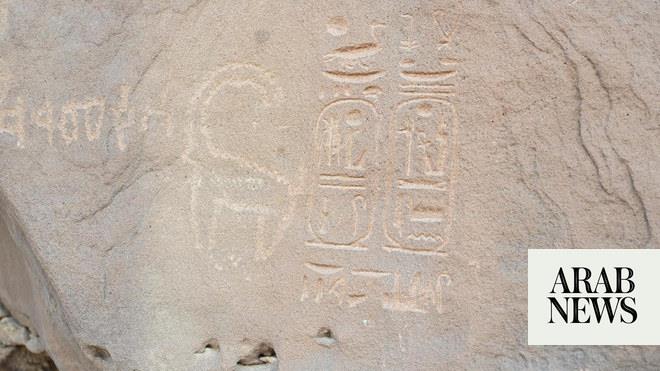
RIYADH: The pharaonic inscription of King Ramses III in Tayma is one of the most significant archaeological discoveries of the 21st century, a find that indicates the depth of trade relations between the Nile Valley and the Arabian Peninsula stretching back more than 3,000 years.
The hieroglyph was found on a rock in Al-Zaydaniyah, near the Tayma oasis in northwestern Saudi Arabia, and bears a royal signature (a double cartouche) of King Ramses III, who reigned from 1192–1160 B.C.
According to Mohammed Al-Najm, former director of Tayma Museum, the inscription, which was discovered in 2010, is one of the most significant finds in the Kingdom and the first archaeological discovery of its type.
Saudi archaeologists confirmed that the site was located on a trade route connecting the Nile Valley to Tayma during the reign of Ramses III. Egyptian caravans traveled the route carrying valuable goods from Tayma, such as incense, copper, gold and silver.
Al-Najm said that the route was marked by royal signatures placed on water wells in the Sinai Peninsula and Arabian Peninsula.
The route passed through the Nile Valley and the port of Qulzum to the city of Suez, where archaeologists have found a temple dedicated to the Egyptian king.
It then passed by sea through Sarabit Al-Khadem, near the port of Abu Zenima on the Gulf of Suez, where inscriptions of King Ramses III were also found, before crossing the Sinai Peninsula and passing through the Wadi Abu Ghada water well near a palm oasis, where a double cartouche similar to the Tayma cartouche, bearing the name of the king, was discovered.
The route continued to the head of the Gulf of Aqaba, passing through the Nahal and Tannimah sites, where double cartouches of King Ramesses III, similar to the Tayma cartouche, were also found. A papyrus indicates that the Egyptian ruler sent people to bring copper from a neighboring land.
Al-Najm said that this inscription marked a turning point in the study of the roots of relations between Egypt and the Arabian Peninsula.
Other inscriptions found in the vicinity include human, mythological and animal figures, as well as geometric patterns. These have been studied and documented, with further research needed to uncover their archaeological and historical significance, he added.







